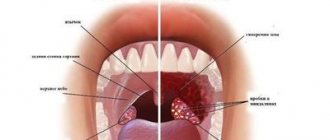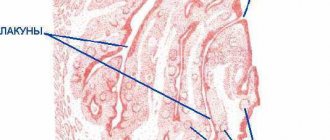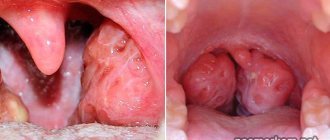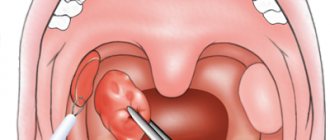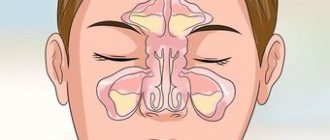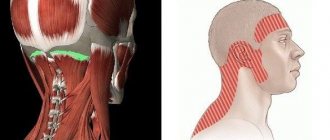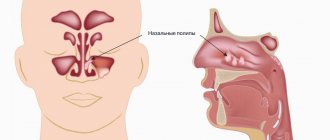About congestion in the throat
Every person has experienced pain, discomfort and a feeling of congestion in the throat many times in their lives.
This is due to the fact that a common cold, which is accompanied by swelling of the pharyngeal mucosa, irritates the nerve endings, creating pain and soreness in the throat. In many cases, an acute process, provided that immunity is not reduced, can be well treated at home in such a way as: gargling, drinking plenty of fluids. And yet, treating an inflammatory disease of the pharynx on your own at home is wrong, and therefore, against the background of such a disease, a chronic disease of the pharynx can develop: pharyngitis, chronic tonsillitis, and even chronic laryngitis. In certain cases, symptoms may appear: anxiety, a lump in the throat and bad breath.
Video treatment of chronic tonsillitis without surgery, 12:47 min.
When you have a sore throat, it is very common to look at your mouth in a mirror. Upon examination, you can see purulent plugs in the throat, white-yellow lumps of a cheesy nature with a rather unpleasant odor, emerging from the mucous membrane of the side walls of the pharynx. Such formations are called caseous plugs, which emerge from the lacunae of the palatine tonsils.
If you suddenly notice plugs in your throat of this nature, then you most likely have chronic tonsillitis. This disease is caused by inflammation in the palatine tonsils. The palatine tonsils are the same tonsils, a collection of lymphoid tissue that is limited from the lateral walls of the pharynx by a capsule. A special feature of the palatine tonsils is their anatomical structure.
Removing tonsillitis plugs: how to remove them correctly?
Removal of caseous masses from the lacunae of the palatine tonsils is the most important part of the treatment of chronic tonsillitis, which should be carried out by an experienced ENT doctor in the clinic. Many patients mistakenly believe that they can remove the purulent contents of the tonsils on their own. A wide variety of items are used: from spoons and matches to toothpicks. Some people manage to remove traffic jams with cotton swabs or their tongue. But we strongly do not recommend resorting to such measures. Attempts to pick out purulent plugs can result in damage to the delicate tissues of the tonsils and infection of the wounds, since rarely do any patients observe proper sterility standards during the procedure.
Modern ENT clinics offer two ways to get rid of plugs: rinsing the palatine tonsils with a syringe and rinsing the palatine tonsils using the Tonzillor apparatus. Removing plugs with a syringe is done less and less often: this method is traumatic and does not allow you to fully wash the tonsils.
The second method is considered the most effective. The nozzle of the Tonsillor device is brought to the tonsil and, like a vacuum cleaner, draws out the purulent contents of the tonsils into the nozzle cup. True, due to the fact that the nozzle cup is opaque, the ENT doctor does not always see whether the tonsils are completely washed - so he has to carry out several additional procedures to remove the caseous masses for sure.
"Doctor Zaitsev's ENT Clinic" offers a third method: removing plugs using a modified attachment of the "Tonsillor" device.
There are no analogues of such a nozzle in any of the Moscow clinics, since it is a unique development of the founder of the “ENT Clinic of Doctor Zaitsev” - Vladimir Mikhailovich Zaitsev and his colleagues.
The improved nozzle is much more convenient than its predecessor. Its rounded edges do not injure the tissue of the tonsils, which sometimes happens with a conventional nozzle, and the transparent cup of the nozzle, into which the contents of the lacunae are washed out, immediately helps the doctor understand when the procedure can be completed without conducting unnecessary sessions. Thereby saving the patient time and money. The attachment can be used even when treating small patients - its small size is ideal for children.
Why shouldn't you remove throat plugs yourself?
If chronic tonsillitis has reached the stage of formation of plugs in the throat, then you will not be able to get rid of them on your own, without resorting to the help of a doctor. Quite often, the majority of those who encounter blockages in the throat, given the pain and bad breath, resort to removal on their own. This is achieved by pressing on the tonsil with your fingers, picking out plugs from the lacunae with a spoon or match. This method is categorically inappropriate, since the superficial part of the plug is removed, and not the depth of the tonsil.
Congestion in the throat is the result of pathomorphological processes that occur in the palatine tonsils as a result of chronic inflammation. Also, along with plugs in the throat, liquid fractions of pus may be present. Therefore, in order to get rid of congestion in the throat, it is necessary to influence all important components of the pathogenesis of chronic tonsillitis .
Independent methods of removing plugs in the throat will only aggravate the course of the disease (traumatization of tonsil tissue), which will further activate the scarring process in the area of the lacunae, which ultimately complicates the process of evacuation of purulent plugs. Neither all kinds of rinsing, nor other methods of self-medication will help properly, which, on the contrary, can ultimately lead to decompensation of chronic tonsillitis and the creation of plugs in the throat.
Removal with a cotton swab
This procedure should begin an hour and a half after eating in a well-lit room. To reduce the risk of tonsil infection, you should brush your teeth, rinse your mouth, and be sure to wash your hands, wiping them afterwards with a dry paper towel. Then you can proceed with the following actions:
- We stand in front of the mirror and pull the edge of the cheek on the desired side.
- Using a sterile cotton swab, gently press on the anterior palatine arch (or on the area of the base of the tonsil).
- Slowly move the tampon to the top of the tonsil, trying to squeeze the plug out of the lacuna.
- Once the cork is visible, lightly pry it with a cotton swab and remove it.
IMPORTANT. It is strictly forbidden to squeeze out plugs with your fingers, as this can lead to injury (with nails) and infection in the oral cavity.
If attempts to remove plugs on your own cause pain, you should stop immediately and consult a doctor as soon as possible.
Causes of purulent plugs in the throat
Unpleasant sensations and pain in the throat accompany any person throughout the illness. The symptoms and consequences of a disease such as a congestion in the throat may be different for everyone, and are determined only by a medical specialist. Diagnostics involves a blood test, smear and other medical procedures that allow you to correctly establish a diagnosis and prescribe effective treatment. Redness and sore throat can be eliminated at home, but purulent plugs in the throat of various etiologies certainly require special treatment and attention.
The cause of purulent plugs in the throat can be different. But the result of any cause may be inflammation of the tonsils. The tonsils are lymphoid tissue that protect the throat from various infections. A severe inflammatory process in the tonsils can be caused by various microbes, which is why a correct diagnosis can only be made by obtaining a smear of the larynx.
Sore throat can be caused by microbes such as streptococcus, pneumococcus, staphylococcus or adenoviruses, and diphtheria - by diphtheria microbes. Only timely treatment of purulent plugs in the throat will help avoid serious complications .
What not to do
White pustules on the tonsils appear with follicular tonsillitis. The disease is accompanied by high fever and sore throat when swallowing. Bacterial inflammation can only be treated with antibiotics.
The local effect on the tonsils consists only of rinsing and lubricating with Iodinol. No other types of mechanical impact are carried out. This is fraught with the spread of bacteria throughout the body, leading to sepsis.
Important! If you see purulent formations in the throat at a high temperature, consult a doctor immediately.
Purulent plugs in the throat in children and adults
In children of younger and older age categories, sore throat can often be observed with purulent plugs in the throat. Follicular and lacunar tonsillitis is marked by yellow and white purulent plugs; blisters with pus cover almost all the tonsils. The disease is accompanied by headaches, fever, general weakness, and loss of appetite. There are strong changes in the blood test, they are associated with a high content of leukocytes.
If there is suddenly a suspicion of diphtheria sore throat, the sick child should be hospitalized immediately. This disease is very dangerous with all sorts of complications in the future. Diphtheria is marked by purulent gray deposits, which cause great pain when removed. Suspicion of such a disease may arise already at the first examinations.
Parents often have questions about tonsil removal; such advice can only be given by the attending physician. Often, a child can simply “outgrow” tonsil disease, but if there is a serious risk of complications in the heart, joints and kidneys, then it is worth consulting with experienced specialists before making a decision.
Adult patients often turn to the doctor with the same questions about purulent plugs in the throat. A person constantly suffers from sore throat, pharyngitis, and purulent plugs in the throat are caused by the same diseases. Reduced immunity, poor environmental conditions, improper self-medication - all this causes chronic tonsillitis (chronic inflammation of the tonsils). With periodic exacerbations, chronic tonsillitis manifests itself as sore throat. The constant appearance of purulent plugs in the throat and bad breath bring anxiety and exhaust the patient.
An extremely dangerous complication is in the form of a peritonsillar abscess, which turns into phlegmon of the neck, which threatens the patient in case of negligence in the treatment of chronic tonsillitis. Diseases of the joints, heart and kidneys are very dangerous, as complications after previous diseases associated with the presence of purulent plugs in the throat.
Treatment methods for chronic tonsillitis
Chronic inflammation of the palatine tonsils in the early stages is treated conservatively, of course, under the supervision of an otolaryngologist. Only an ENT doctor, after an examination and confirmation of the diagnosis, can prescribe an effective treatment regimen and carefully remove plugs, which will significantly increase the remission stage and make you forget about the symptoms of the disease for a long time.
Drug therapy includes:
- a course of taking antibacterial drugs (“Azithromycin”, “Augmentin”, “Summamed”, etc.);
- treatment of the tonsils with antiseptic drugs (Lugol);
- taking antihistamines to relieve swelling of the mucous membranes (Claritin, Zodak, etc.);
- gargling with antiseptics (“Miramistin”, “Chlorhexidine”, “Furacilin”);
- irrigating the pharynx with anti-inflammatory sprays (Ingalipt, Hexoral).
Among the traditional medicine recipes in the fight against inflamed tonsils, gargling with herbal decoctions (sage, chamomile, St. John's wort) and inhalation, where decoctions of the same medicinal herbs are used as a solution, have proven themselves to be effective.
Friends! Timely and correct treatment will ensure you a speedy recovery!
Physiotherapeutic procedures that are carried out in the ENT clinic help to consolidate the positive effect of drug therapy and speed up the healing process: laser therapy, ultraviolet irradiation, vibroacoustic effects, etc.
Make an appointment right now!
Call us by phone or use the feedback form
Sign up
Folk remedies can be used in parallel with prescribed therapy (but not instead!) and only in consultation with an ENT doctor.
Only an ENT doctor should remove one or another drug from the treatment regimen or add a new one. Self-medication is unacceptable: many cases have been recorded where improper treatment of inflamed tonsils led to complications in other human organs and systems: complications in the heart, kidneys and joints.
I would like to dwell in more detail on how to properly remove traffic jams.
Treating throat congestion
Congestion in the throat and bad breath can be so distressing that patients are often ready to resort to any measures, even removal of the tonsils (tonsillectomy). Such a solution in certain cases is very acceptable, but the point is that any operation must be seriously justified. Sometimes, having rushed to remove the tonsils and upset the anatomy and the natural protective mechanisms of the pharynx, in the near future a person may encounter a form of chronic pharyngitis, which is very difficult to treat and intensively worsens the quality of life. That is why, if you have plugs in your throat, do not under any circumstances delay removing your tonsils.
Congestion in the throat is not an indication for tonsillectomy, taking into account all the canons of otorhinolaryngology. With the right approach to treating purulent plugs in the throat, you can do without surgery, solving the problem in a conservative way . The ENT-Asthma clinic has developed and successfully used an effective method for treating chronic tonsillitis, consisting of a set of procedures. All actions are aimed, first of all, at eliminating all the important links in the pathogenesis of this disease, which allows you to actually get rid of congestion in the throat, preserving the tonsils.
Washing the lacunae of the tonsils
This method is considered the most effective for removing not only caseous plugs, but also purulent accumulations. It can be carried out:
- Using a syringe. An antiseptic solution is drawn into a sterile syringe, after which a special attachment (thin and curved) is put on it instead of a needle. It is this that is injected into the gaps (the 2-3 largest ones) and the pressure of the antiseptic washes out purulent and other contents from there.
- Vacuum device. Before the procedure, the mucous membrane of the tonsils is anesthetized (usually with lidocoine). Then a “cup” that fits tightly to the surface is placed above the tonsil, after which negative pressure is created using a vacuum, which removes the contents from the lacunae. After the procedure, an antiseptic solution is introduced to prevent the formation of new plugs.
Typically, such treatment is carried out in a course (10-15 procedures every other day).
Tonsil plugs: causes
To find out the etiology of the occurrence of purulent accumulations in the tonsils, you need to understand what role the palatine tonsils play in the body.
The tonsils are an important organ of the human immune system, which is the first to stand in the way of bacteria and viruses that enter the body through the mouth. As soon as “strangers” reach the surface of the tonsils, they begin to intensify the production of leukocytes, which enter into battle with pathogenic microorganisms. As a result of such “battle actions”, dead leukocytes, bacteria, and epithelial remains accumulate in the lacunae of the tonsils. Over time, minerals accumulate here, and the contents of the lacunae begin to harden, forming caseous plugs.
The main cause of traffic jams is chronic tonsillitis. But they can also form in the palatine tonsils for various reasons:
- accumulation of staphylococci, streptococci, pneumococci and other bacteria;
- in people who have a weak immune system;
- frequent sore throats;
- the presence of herpes virus and fungi in the body;
- dental problems (caries);
- viral infections (flu, ARVI).
Each of the above reasons can provoke inflammation of the tonsils. The risk of accumulation of caseous masses in the lacunae of the tonsils is increased by unhealthy diet, smoking, and alcohol consumption.
Traffic jams do not form just like that, for no reason. They are a consequence of another disease and signal that an inflammatory process is underway in the body.
Physiotherapy
The main goal of physiotherapeutic procedures is to remove purulent plugs and reduce inflammation and prevent the progression of the disease.
IMPORTANT. Physiotherapy is contraindicated during periods of exacerbation!
The main physiotherapeutic methods in the treatment of tonsil plugs are:
- Laser irradiation. Helps improve blood and lymph in the area of inflammation, while providing an antimicrobial effect. A painless procedure that lasts no more than five minutes. Typically, the course of treatment consists of six procedures.
- Ultraviolet irradiation. The procedure has a destructive effect on bacteria, due to which inflammation subsides and the protective properties of the tonsils increase. Treatment duration is 10-15 procedures.
- Ultrasonic aerosols. They allow you to direct the necessary medications to hard-to-reach places (deep into the lacunae) using an ultrasound device, significantly increasing their effectiveness. The duration of the course of treatment is determined by the doctor.
Why do you need to rinse your tonsils?
Human tonsils (tonsils) have a special structure. They have deep slits (ducts) called lacunae. This is a place where different types of bacteria accumulate and where drainage is impaired. Food debris, dead epithelial cells and microorganisms that decompose organic matter contribute to the formation of plugs in the lacunae. Many people face a problem during upper respiratory tract diseases. The plugs are white or yellowish lumps. In this case, the tonsils become a source of infection. From them, toxins enter the body and damage internal organs.
When treatment is not started in a timely manner and the resulting lumps are not eliminated, the tonsils become inflamed and tonsillitis develops. If the disease becomes chronic, various complications are possible, in particular glomerulonephritis and rheumatism.
